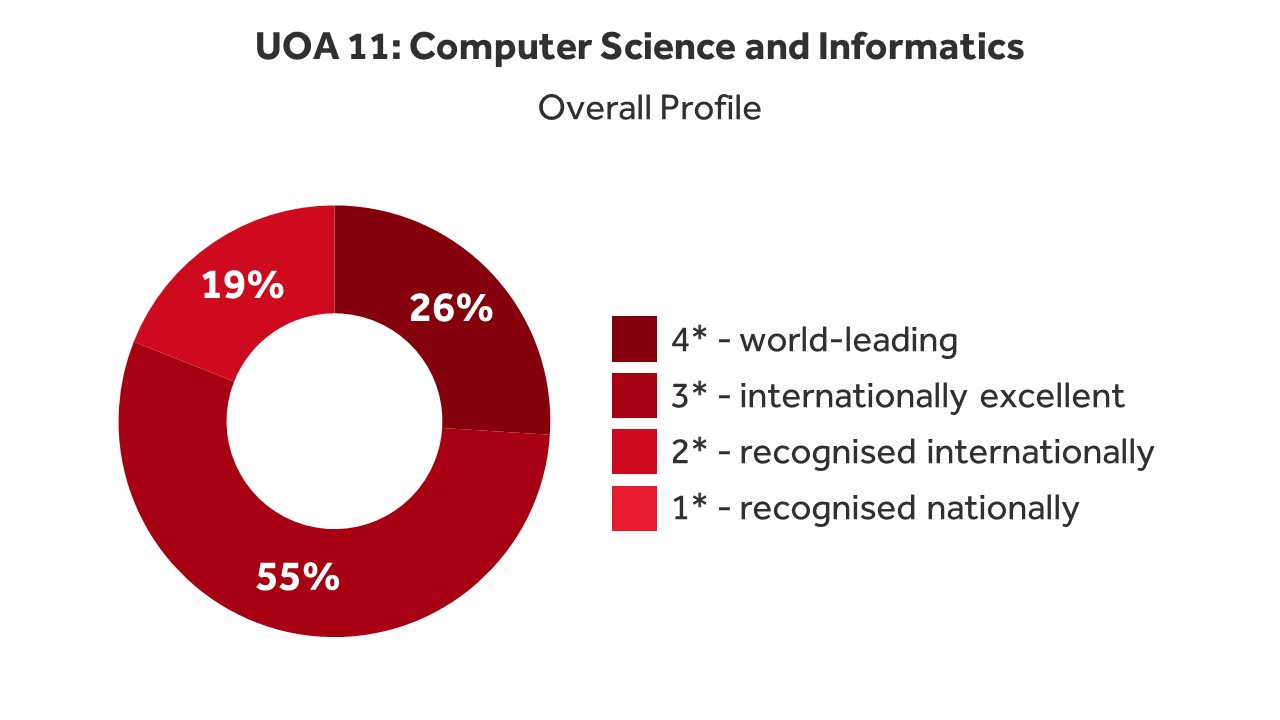Research submitted to UOA11 is from the University’s Computer Science Research Division which works closely with other Divisions in the School of Mathematical, Physical and Computational Sciences (SMPCS). The Division has extensive working relationships with local, regional and global business and third sector organisations which have supported and strengthened our research agenda, resulting in significant impact.
Unit of Assessment 11

Overall quality profile
Subprofiles
| World-leading (4*) |
Internationally excellent (3*) |
Recognised internationally (2*) |
Recognised nationally (1*) |
|
|---|---|---|---|---|
| Research outputs | 13% | 58% | 29% | 0% |
| Research impacts | 75% | 25% | 0% | 0% |
| Research environment | 0% | 88% | 13% | 0% |
Our research
Our work is organised in three groups, which represent our applied and interdisciplinary approach to data and computational science:
- Computational Vision (CV) addresses computational issues of perception and reasoning in relation to image interpretation, at the forefront of international security research. The group exploits synergies between computer vision and image analysis and real-world applications, covering critical infrastructure protection to border security to remote sensing.
- Data Science and Artificial Intelligence (DSAI) focuses on machine learning, data mining, big data analytics devoted to algorithms, and techniques and applications for data-driven knowledge discovery from big data. The group concentrates on algorithms for data mining and machine learning, as well as systems and applications for multidisciplinary data-driven knowledge discovery.
- Advanced Computing for Environmental Science (ACES) conducts research in computer science to accelerate environmental science. The group develops and exploits advanced computer science techniques for deployment in real applications of environmental science, leveraging the world-class meteorology and mathematics research within SMPCS and close collaborations with the UK Met Office and the European Centre for Medium-Range Weather Forecasts (ECMWF).
Staff and doctoral students
We submitted 11 staff in UOA11 (10.4 FTE), including 5 Professors, 2 Associate Professors and 4 Lecturers; overall 4 are ECRs.
Over the assessment period for REF2021, 45 students were awarded their doctorate. We typically have about 26 PhD students at any time (from 14 countries in 2019/20).
Research centres and partnerships
We are involved in significant interdisciplinary collaboration, both within the University (e.g. with Meteorology and the Institute for Food, Nutrition and Health) and with external partners. Close collaborators include the Met Office, European Centre for Medium-Range Weather Forecasts (ECMWF), Institute for Environmental Analytics (IEA), the Computational Modelling Services unit of the National Centre for Atmospheric Science (NCAS), and both the Centre for Environmental Data Analysis (CEDA) and the Scientific Computing Department of the UKRI Science and Technology Facilities Council (STFC). We work with international companies (e.g. BAE Systems, Thales, Veridos) and policymakers and planners (e.g. UK Home Office, Ministry of the Interior, Finland), Fraport, Milan metro).
We lead on major collaborative EU projects. This includes, for example, CRITICAL-CHAINS and PROTECT, which were the result of focused partnership-building through the IMG-S network of experts in the security domain (SMI2G) and the EU’s SEREN network.
Impact case studies
Examples of the impact our research has had at local, national and global levels.



